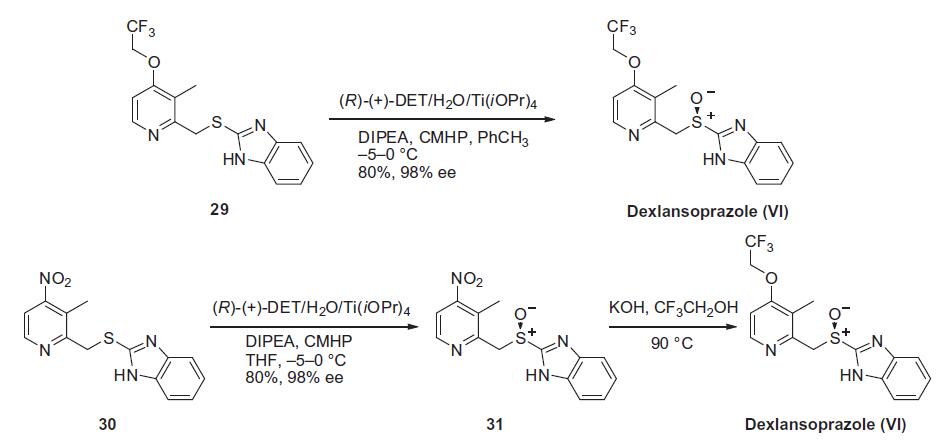|
| | R-(+)-Lansoprazole Basic information |
| Product Name: | R-(+)-Lansoprazole | | Synonyms: | Lansoprazole Impurity 14;Dexlansoprazole related impurities 2;(R)-2-[[[3-Methyl-4-(2,2,2-trifluoroethoxy)-2-pyridyl]methyl]sulfinyl]-1H-benzimidazole;1H-Benzimidazole, 2-[(R)-[[3-methyl-4-(2,2,2-trifluoroethoxy)-2-pyridinyl]methyl]sulfinyl]- (9CI);1H-Benzimidazole, 2-[[[3-methyl-4-(2,2,2-trifluoroethoxy)-2-pyridinyl]methyl]sulfinyl]-, (R)-;R-(+)-Lansoprazole;Dexlansoprazole;2-[(R)-[[3-Methyl-4-(2,2,2-trifluoroethoxy)-2-pyridinyl]methyl]sulfinyl]-1H-benzimidazole | | CAS: | 138530-94-6 | | MF: | C16H14F3N3O2S | | MW: | 369.36 | | EINECS: | 1308068-626-2 | | Product Categories: | DEXILANT;APIs;Chiral Reagents;Intermediates & Fine Chemicals;Pharmaceuticals;Sulfur & Selenium Compounds | | Mol File: | 138530-94-6.mol |  |
| | R-(+)-Lansoprazole Chemical Properties |
| Melting point | 66-68?C | | Boiling point | 555.8±60.0 °C(Predicted) | | density | 1.50±0.1 g/cm3(Predicted) | | storage temp. | Sealed in dry,2-8°C | | solubility | Chloroform (Slightly), DMSO (Slightly), Methanol (Slightly) | | pka | 9.56±0.10(Predicted) | | form | Solid | | color | Off-White to Dark Brown | | Stability: | Hygroscopic |
| | R-(+)-Lansoprazole Usage And Synthesis |
| Description | The mechanism of PPIs involves the irreversible binding to the hydrogen/potassium adenosine triphosphatase enzyme system, commonly
referred to as the gastric proton pump, of the gastric parietal cell. As
the last stage in gastric acid secretion, blockade of the gastric proton
pump is an effective treatment for a variety of diseases requiring acid suppression, such as heartburn, peptic ulcers, and GERD. Dexlansoprazole is the latest PPI to hit the market, joining the ranks of omeprazole,
rabeprazole, pantoprazole, esomeprazole, and lansoprazole, and is the Renantiomer of the racemic lansoprazole. Compared to its predecessors,
dexlansoprazole exhibits improved pharmacokinetics with slower clearance and longer terminal half-life. In addition, dexlansoprazole utilizes a
novel DDR technology; drug release is optimized through the use of
granules with different pH-dependent dissolution profiles, thereby providing an initial release in the proximal small intestine within 1-2 h of
administration followed by a subsequent release at distal regions of the
small intestine several hours later. With its longer duration of action
culminating in more effective acid suppression, dexlansoprazole may
have an advantage over conventional PPIs that possess single release
formulations (immediate or delayed).
Similar to all PPIs, dexlansoprazole
is a prodrug that consists of pyridine and benzimidazole rings with a
latent sulfenamide moiety. In order to form the disulfide bond with
cysteine residues of the proton pump, dexlansoprazole must be activated
through two protonations followed by a spontaneous rearrangement to
unmask the sulfenamide. | | Description | Lansoprazole is a proton pump inhibitor that irreversibly inactivates the H+/K+-stimulated ATPase pumps in parietal cells, inhibiting gastric acid secretion and increasing intragastric pH. It is a 1:1 racemic mixture of (R)-lansoprazole and (S)-lansoprazole, both of which are pharmacologically active. (R)-Lansoprazole is an enantiomerically pure form of lansoprazole. It can inhibit acid formation in isolated canine parietal cells with an IC50 value of 59 nM and inhibit the H+/K+-ATPase with an IC50 value of 4.2 μM. | | Chemical Properties | Brown Solid | | Originator | Takeda (Japan) | | Uses | antiulcer, proton pump inhibitor | | Uses | Acts as a gastric proton pump inhibitor and an antiulcerative | | Uses | The R-enantiomer of Lansoprazole; a gastric proton pump inhibitor. An antiulcerative | | Definition | ChEBI: Dexlansoprazole is a sulfoxide and a member of benzimidazoles. | | Brand name | Kapidex | | Clinical Use | Takeda Pharmaceuticals received approval of dexlansoprazole, a
dual release formulation of the (R)-isomer of lansoprazol proton
pump inhibitor (PPI) already in the market, from the FDA in January
2009. Dexlansoprazole is a delayed release capsule for the oncedaily,
oral treatment of heartburn associated with symptomatic
non-erosive gastroesophageal reflux disease (GERD), the healing
of erosive esophagitis (EE) and the maintenance of healed EE.
The dual release formulation is designed to provide two separate
releases of medication, one at 1–2 h and then another at 4–5 h after
treatment, for extended efficacy in the treatment of GERD. | | Side effects | The most commonly recorded adverse reactions that occurred at a higher incidence than placebo were diarrhea, abdominal pain, nausea, vomiting, flatulence, and upper respiratory tract infection. As dexlansoprazole inhibits gastric acid secretion, its use is expected to interfere with the absorption of drugs with pH-dependent oral bioavailability. Since the HIV protease inhibitor atazanavir is dependent on gastric acid for absorption, dexlansoprazole should not be co-administered with atazanavir to avoid a loss of therapeutic efficacy. While co-administration of dexlansoprazole did not affect the pharmacokinetics of warfarin or INR (international normalized ratio: the ratio of a patient s prothrombin time to a normal sample), there have been reports of increased INR and prothrombin time in patients receiving concomitant treatment with PPIs and warfarin. Since increases in INR and prothrombin time may lead to abnormal bleeding and possibly death, concomitant use of dexlansoprazole and warfarin may necessitate monitoring for increases in INR and prothrombin time. | | Synthesis | Similar
to the synthesis of the chiral sulfoxide of armodafinil vide supra, the
preparation of the chiral sulfoxide of lansoprazole utilized the catalytic
oxidation method developed by Kagan and co-workers
(the Scheme). Two routes have been reported that describe the
preparation of dexlansoprazole on large scale. The first route
developed by Takeda reacts commercially available thioether 29,
also used to make lansoprazole, under the Kagan asymmetric oxidation
conditions and the alternative route utilizes the cheaper commercial intermediate nitrosulfide 30 in the analogous asymmetric
oxidation by Kagan). Thus, the catalyst complex
consisting of (+)-DET, Ti(OiPr)4 and water was formed in the presence
of thioether 29 in toluene at 30¨C40??C. The reaction mixture
was then cooled to 5 ??C and DIPEA and cumene hydroperoxide
(CMHP) were added to give, after aqueous work-up and in situ crystallization
from the organic layer, dexlansoprazole (VI) in 98% ee.
No yield was given in the patent. An alternate, but similar, sequence
was also described wherein the nitrosulfide intermediate 30 was
subjected to similar oxidative conditions that gave intermediate nitro
compound 31 in 80% yield and 98% ee. Compound 31 was treated
with KOH and trifluoroethanol to provide dexlansoprazole (VI). 
|
| | R-(+)-Lansoprazole Preparation Products And Raw materials |
|



